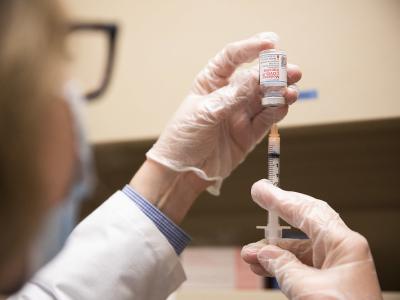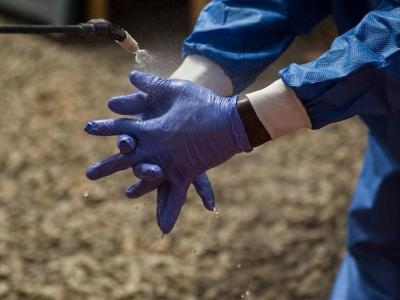BARDA exercises contract option for next-generation anthrax vaccine
Emergent BioSolutions announced yesterday that the US Health and Human Services (HHS) Biomedical Advanced Research and Development Authority (BARDA) has exercised a contract option worth $261 million to buy doses of anthrax vaccine adsorbed with adjuvant (AV7909) for the Strategic National Stockpile (SNS).
The contract option was part of a 2016 deal worth up to $1.5 billion with BARDA to develop AV7909 for postexposure prophylaxis and to deliver an initial 3 million doses to the SNS, according to a press release from the company. The option will supply another 50 million doses.
Robert Kramer, president and chief executive officer of Emergent BioSolutions, said in the statement that as the government transitions from anthrax vaccine adsorbed (BioThrax) to AV7909, the company looks forward to starting delivery of doses under the contract base and its option as well as maintaining supplies of BioThrax for pre-exposure vaccination for military members and other high-risk people.
The company recently completed enrollment of a phase 3 study of AV7909, which offers a two-dose schedule and a rapid immune response, according to Abbey Jenkins, senior vice president and vaccine business unit head at Emergent BioSolutions. The company expects to complete the trial in late 2020.
Jul 30 Emergent BioSolutions press release
Neuroimaging study of Zika-affected infants spotlights abnormalities
A retrospective analysis of neuroimaging findings on Brazilian babies exposed to Zika virus during pregnancy found that abnormalities were common, especially in those with severe symptoms and those who were exposed during the first trimester. Researchers from Brazil and California reported their findings today in JAMA Network Open.
They examined the imaging findings (computed tomography and/or magnetic resonance imaging) of 110 babies who were seen at a referral center in Rio de Janeiro during the 2015 to 2016 Zika epidemic. Their goal was to assess if the findings were linked to clinical outcomes and timing of mothers' Zika infections.
Of the 110 infants, 71 (65%) had abnormal findings, and some of the most common were brain calcifications, cortex malformations, ventriculomegaly, and reduced brain volume. Of those, the vast majority (96%) were diagnosed as having severe Zika infection at birth. Of 39 Zika-exposed babies who had normal neurologic findings at birth, 4 (10%) had abnormal neuroimaging findings.
When researchers analyzed the findings by trimester of Zika exposure, they found that 63% of babies were born to mothers infected in the first trimester, 13% in the second trimester, and 1% in the third trimester. The odds of abnormal neuroimaging were 7.9 times greater in in babies exposed during the first trimester compared with the other trimesters combined.
In a commentary in the same issue, Sarah Mulkey, MD, PhD, with the departments of pediatrics and neurology at The George Washington University School of Medicine and Health Sciences in Washington, DC, wrote that congenital Zika infection has some unique neuroimaging findings compared to other congenital infections, with cerebral calcification typically appearing in the subcortical area and in the basal ganglia. She also noted that the cerebral mantle can be severely thin, a finding unusual for other congenital infections that cause microcephaly.
Early neuroimaging is one of the most useful investigations in Zika-exposed babies, but access is limited in some areas, which may limit clinicians' ability to identify all affected infants. When available, cranial ultrasound should be the first-line imaging test, used alongside neurological examination, ophthalmologic exam, and brainstem auditory evoked potentials.
Jul 31 JAMA Netw Open abstract
Jul 31 JAMA Netw Open commentary
New findings: UK Lyme disease cases higher than originally thought
An analysis of a large clinical database found that the Lyme disease incidence in the United Kingdom is about three times higher than originally thought and people in all areas are at risk, a research team reported yesterday in BMJ Open.
They examined Lyme disease data from January 2001 through December 2012 from a primary care database that covers about 8% of the UK population and 658 of its primary care practices. The team found that Lyme disease cases rose rapidly over the study period, with an incidence rate estimate of 12.1 per 100,000 people each year and an estimated 7,738 cases in 2012. However, they note that the numbers are probably underestimates due to incomplete recording of antibiotic use by specialists and hospital doctors.
Lyme disease was reported from every UK region, but the highest incidence and largest number of cases were from Scotland, a moist area suitable for ticks where walking is popular and Lyme disease awareness is higher, followed by Southwest and South England. The team projected that if cases continue to rise, the UK's total for 2019 could be more than 8,000.
Researchers concluded that the findings should lead to enhanced awareness of the need for Lyme disease prevention measures.
Jul 30 BMJ Open abstract
Yellow fever outbreak in Ivory Coast sickens 89, kills 1
A yellow fever outbreak in Ivory Coast has sickened 89 people, including 1 fatally. The cases have occurred in recent weeks near and in the capital city, Abidjan, the country's health ministry said in a statement yesterday.
The ministry also said the yellow fever outbreak is taking place concurrent to an ongoing dengue outbreak. Both viruses are spread by mosquitoes, and both can be contained through eliminating mosquito breeding sites and using insecticides.
The ministry of health also said yellow fever vaccination will be used on "people living in immediate surroundings of patients to break the chain of transmission."
Jul 30 Ministry of Health statement








